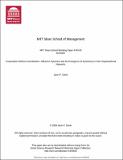| dc.contributor.author | Davis, Jason P. | |
| dc.date.accessioned | 2011-11-04T20:04:27Z | |
| dc.date.available | 2011-11-04T20:04:27Z | |
| dc.date.issued | 2009-08 | |
| dc.identifier.uri | http://hdl.handle.net/1721.1/66947 | |
| dc.description.abstract | This paper explores the emergence of synchrony in cooperative inter-organizational networks. While some research suggests that synchronizing organizational actions like product releases is a form of collective behavior that generates advantages for organizations, most existing network theory focuses on dyads and not the larger organizational groups where networked cooperation is relevant. As a result, we know a lot about resource mobilization and information diffusion across dyads, but very little about how cooperation occurs in larger networks where collective behaviors like synchrony are important. Using a simple computational model grounded in prior research on inter-organizational networks, this paper develops a theoretical framework linking temporal dynamics to network theory that sheds light on the emergence of synchrony, why it emerges faster in some networks than others, and how organizations can shape synchrony to their own advantage. Specifically, I find that synchrony emerges from influence across network ties without the need for a central coordinator or exogenous technology cycle. It emerges though a series of cooptation events across network ties wherein social influence accumulates to synchronize some organizations with others. The magnitude and time to reach synchrony varies predictably with features of network structure such as network size (N), mean degree (K), and tie strength (e), although an unexpected finding is that clustering (CC) diminishes synchrony by generating coalitions with rhythms that vary too widely. These dependencies can be understood with reference to three mechanisms – accelerated, coalitional, and conflicting influence – that shape cooptation dynamics. Finally, intentional coordination across interorganizational relationships accelerates the time to synchronize the entire network, creating temporal spillovers to non-coordinating organizations; moreover, coordinating organizations benefit from increased synchrony performance – i.e., they increase the relative likelihood that network synchronization tips to their own underlying rhythm. The magnitude of this performance advantage depends on network size (N) and mean degree (K), but not on tie strength (e) or clustering (CC). | en_US |
| dc.description.sponsorship | Support for
this research was provided by MIT’s Sloan School of Management. | en_US |
| dc.language.iso | en_US | en_US |
| dc.publisher | Cambridge, MA; Alfred P. Sloan School of Management, Massachusetts Institute of Technology | en_US |
| dc.relation.ispartofseries | MIT Sloan School of Management Working Paper;4743-09 | |
| dc.subject | influence dynamics | en_US |
| dc.subject | interorganizational networks | en_US |
| dc.title | Cooperation Without Coordination: Influence Dynamics and the Emergence of Synchrony in Inter-Organizational Networks | en_US |
| dc.type | Working Paper | en_US |
